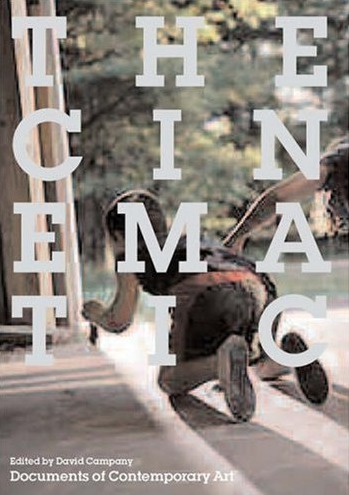David Campany (ed.): The Cinematic (2007)
Filed under book | Tags: · art history, cinema, contemporary art, film, film history, photography, video art

“The cinematic has been a springboard for the work of many influential artists, including Victor Burgin, Philip-Lorca diCorcia, Stan Douglas, Nan Goldin, Douglas Gordon, Cindy Sherman, and Jeff Wall, among others. Much recent cinema, meanwhile, is rich with references to contemporary photography. Video art has taken a photographic turn into pensive slowness; photography now has at its disposal the budgets and scale of cinema. This addition to Whitechapel’s Documents of Contemporary Art series surveys the rich history of creative interaction between the moving and the still photograph, tracing their ever-changing relationship since early modernism.
Still photography—cinema’s ghostly parent—was eclipsed by the medium of film, but also set free. The rise of cinema obliged photography to make a virtue of its own stillness. Film, on the other hand, envied the simplicity, the lightness, and the precision of photography. Russian Constructivist filmmakers considered avant-garde cinema as a sequence of graphic “shots”; their Bauhaus, Constructivist and Futurist photographer contemporaries assembled photographs into a form of cinema on the page. In response to the rise of popular cinema, Henri Cartier-Bresson exalted the “decisive moment” of the still photograph. In the 1950s, reportage photography began to explore the possibility of snatching filmic fragments. Since the 1960s, conceptual and postconceptual artists have explored the narrative enigmas of the found film still. The Cinematic assembles key writings by artists and theorists from the 1920s on—including László Moholy-Nagy, Pier Paolo Pasolini, Victor Burgin, Jeff Wall, and Catherine David—documenting the photography-film dialogue that has enriched both media.”
Contributors:
Roland Barthes, Jean Baudrillard, Raymond Bellour, Anton Giulio Bragaglia, Victor Burgin, Henri Cartier-Bresson, Catherine David, Thierry de Duve, Gilles Deleuze, Philip-Lorca diCorcia, Philippe Dubois, Régis Durand, Sergei Eisenstein, Mike Figgis, Hollis Frampton, Susanne Gaensheimer, Nan Goldin, Chris Marker, Christian Metz, Laura Mulvey, László Moholy-Nagy, Beaumont Newhall, Uriel Orlow, Pier Paolo Pasolini, Constance Penley, Richard Prince, Steve Reich, Carlo Rim, Raul Ruiz, Susan Sontag, Blake Stimson, Michael Tarantino, Agnès Varda, Jeff Wall, Andy Warhol, and Peter Wollen.
Publisher Whitechapel Art Gallery, London, 2007
Documents of Contemporary Art series
ISBN 0854881522, 9780854881529
221 pages
PDF (updated on 2022-11-29)
Comments (2)Pasi Väliaho: Mapping the Moving Image: Gesture, Thought and Cinema Circa 1900 (2010)
Filed under book | Tags: · 1900s, biopolitics, cinema, epistemology, film, film history, media archeology, perception

“In Mapping the Moving Image, Pasi Väliaho offers a compelling study of how the medium of film came to shape our experience and thinking of the world and ourselves. By locating the moving image in new ways of seeing and saying as manifest in the arts, science and philosophy at the turn of the twentieth century, the book redefines the cinema as one of the most important anthropological processes of modernity. Moving beyond the typical understanding of cinema based on optical and linguistic models, Mapping the Moving Image takes the notion of rhythm as its cue in conceptualizing the medium’s morphogenetic potentialities to generate affectivity, behaviour, and logics of sense. It provides a clear picture of how the forms of early film, while mobilizing bodily gestures and demanding intimate, affective engagement from the viewer, emerged in relation to bio-political investments in the body. The book also charts from a fresh perspective how the new gestural dynamics and visuality of the moving image fed into our thinking of time, memory and the unconscious.”
Publisher Amsterdam University Press, Amsterdam, 2010
Film Culture in Transition series
ISBN 9089641408, 9789089641403
256 pages
PDF (updated on 2021-4-9)
Comment (0)Michel Chion: The Voice in Cinema (1984–) [EN, ES]
Filed under book | Tags: · cinema, film, film history, film sound, film theory, sound recording, voice

“How can a voice whose source is never seen—such as Hal in 2001: A Space Odyssey or the mother of Norman Bates in Psycho—have such a powerful hold on an audience? When does “synchronized sound” fail to link bodies to their voices, and how do such great stylists of sound film as Jacques Tati, Kenji Mizoguchi, and Marguerite Duras deploy the power of the voice?
In this brilliant essay, Michel Chion, internationally cited authority on the history and poetics of film sound, examines the human voice in cinema. The Voice in Cinema begins with the phenomenon of film’s hidden, faceless voices and their magical powers, particularly in the context of Lang’s Testament of Dr. Mabuse. Chion then explores subjective voices, bonding and entrapment by telephone, voice-thieves, screams (male and female), siren calls, and the silence of mute characters-all uniquely cinematic deployments. In conclusion, Chion considers “the monstrous marriage of the filmed voice and body” as embodied in Norman Bates. Claudia Gorbman’s fluent translation retains Chion’s sophisticated and accessible style, introducing readers to a distinct and paradigm-changing voice on film.”
First published as La voix au cinéma, Cahiers du Cinema, Paris, 1984.
English edition
Edited and translated by Claudia Gorbman
Publisher Columbia University Press, 1999
ISBN 0231108222, 9780231108225
183 pages
Review: Tim Anderson (Echo, 2000).
Publisher (EN)
The Voice in Cinema (English, trans. Claudia Gorbman, 1999, updated on 2020-9-19)
La voz en el cine (Spanish, trans. Maribel Villarino Rodriguez, 2004, added on 2020-9-19)

